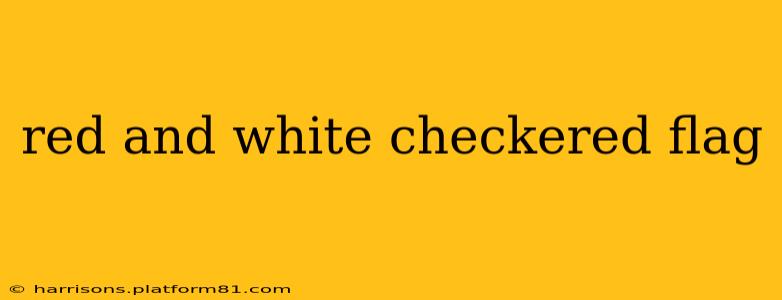The red and white checkered flag is instantly recognizable worldwide as the symbol of the finish line, signifying the culmination of a race, a competition, or a journey. But this iconic symbol holds a rich history and deeper meaning than many realize. This post will delve into the fascinating story of the checkered flag, exploring its origins, symbolism, and enduring presence in popular culture.
What does the checkered flag symbolize?
The checkered flag primarily symbolizes the completion of a race or competition. It's a visual cue indicating that the final competitor has crossed the finish line, marking the end of the event and the beginning of the celebration for the winner. Beyond racing, it's often used metaphorically to represent reaching a goal, achieving a milestone, or finishing a significant task. This broader symbolic use taps into the universally understood concept of a finish line representing accomplishment.
Why is it red and white?
The exact origins of the red and white color scheme are debated, but several theories exist. One prominent theory suggests that the colors originated from early forms of race flags, where the distinctive pattern made it easily visible from a distance, even in poor weather conditions. The strong contrast between red and white ensures clear visibility, regardless of background or lighting. Another suggestion links the colors to British flag traditions, possibly incorporating elements of the Union Jack or other national flags prevalent in the early days of motorsport. The simplicity and high contrast of the design also lend themselves to easy reproduction and recognition across various media and contexts.
What is the history of the checkered flag?
While the precise date of its adoption is unclear, the checkered flag's use in motorsports is believed to have emerged in the early 20th century. Early races often utilized simpler flags, but the checkered pattern gradually gained popularity due to its superior visibility and memorability. Its adoption wasn't a singular event; rather, it was a gradual evolution in racing signaling, eventually becoming the universally accepted symbol we know today. The rise of motorsports, particularly Formula 1 and NASCAR, further cemented its status as the definitive finish-line marker.
How is the checkered flag used today?
Today, the red and white checkered flag remains ubiquitous in various racing disciplines globally, from Formula 1 to NASCAR, IndyCar, and even smaller local races. Its use is standardized, ensuring consistent signaling and comprehension across different events and organizations. Beyond formal races, its imagery is widespread in popular culture, appearing on merchandise, logos, and as a visual metaphor in various media, solidifying its iconic status.
What are some common misconceptions about the checkered flag?
One common misconception is that the number of checkers holds some specific meaning or significance. This is false; the number of squares varies depending on the size and design of the flag, with no standardized count. The core meaning lies in the pattern itself, not the precise number of squares.
Where can I buy a checkered flag?
You can find checkered flags for sale at many online retailers and sporting goods stores. Search online for "red and white checkered flag" for numerous options.
The red and white checkered flag is more than just a fabric; it’s a powerful symbol representing accomplishment, competition, and the thrill of victory. Its enduring legacy speaks to its simple yet effective design and its deeply rooted association with the world of racing and achievement.
